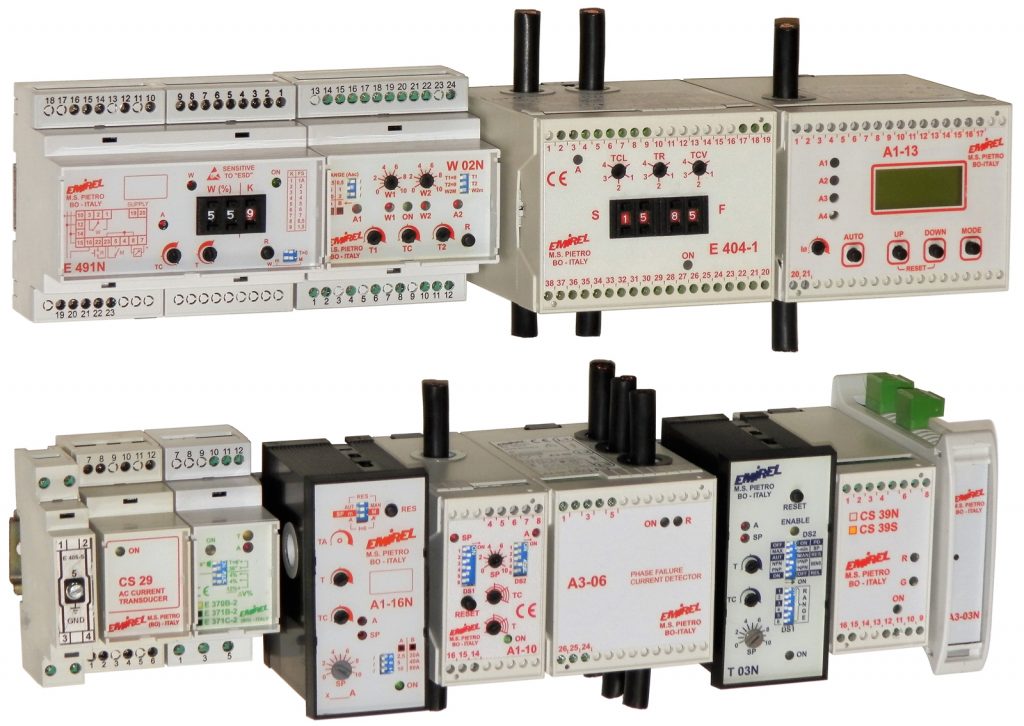The origins of Emirel date back to 1975 when the management of the company LA PUNTIMATIC Snc decided to establish an ELECTRONICS department. The company produced staples for paper and cardboards and nails for wood and it had started the designing of automatic machines for its products. The automatic machines have an electric-electronic part and for this the ELECTRONICS department was born in LA PUNTIMATIC.
The declared philosophy was to protect any inventions with appropriate PATENTS.
For the ELECTRONICS department the first customer was the Production department of La Puntimatic.
The production of staples was provided by 28 automatic single-wire machines, all of them identical and each machine was moved by a three-phase electric motor. Sometimes the machines automatism was jammed and the motor was burned; every month, on the pallet “motors to be rewinded”, there were 4-5 motors accumulated and a craftsman was happy to come to collect for rewind them.
Obviously the replacement of the motor caused the machine down-time and therefore no production.
From this situation the request of the Production was born: “Can something be done to protect the motors?”.
Thus was born the three-phase amperometric relay which was then patented and which in 1979 obtained the SILVER MEDAL at the International Exhibition of Inventions and New Techniques of GENEVA.
The presentation of the relay at INTEL Fair had a certain success, so it was decided to develop further the field of electronic devices of Protection and Control. Single-phase relays, AC and DC voltage relays, wattmetric relays, etc.. were born.
In 1981 Emirel Srl was born, detaching itself from La Puntimatic and taking an independent direction in the field of Industrial Electronics.

The EMIREL PRODUCTS are divided into FAMILIES which are characterized by the physical quantity controlled: temperature, electrical power, current and so on.
The APPLICATIONS are divided into SECTORS or APPLICATION FIELDS.
Among the FAMILIES, the Wattmetric family and the Amperometric family emerge.
These 2 families have in common the Three-Phase Asynchronous Motor.
The Three-Phase Asynchronous Motor is connected to the three-phase mains, from which it absorbs the power Wa=1.73 V I cosφ and returns it to the motor shaft as CxN=Wa.
Legend: V=400Vac mains voltage
I=motor current
cosφ=power factor
C=torque
N=speed of the motor shaft
By controlling the Wa, we have the control of the C (torque) and we can realize the “TORQUE LIMITERS”.
The formula shows that the physical quantities useful for the control of Wa are:
- I (current) from which the AMPEROMETRICS were created.
- cosφ (not used because it is not linear).
- V is not used because it is generally imposed by the DISTRIBUTOR and varies little.
- Wa itself, from which the WATTMETRICS were born.
The AMPEROMETRIC torque limiters and the WATTMETRICS torque limiters represent the core of Emirel production.
The Amperometrics can be Single-Phase or Three-Phase and are widespread because they are less expensive and easy to use.
The Wattmetrics are more precise and sensitive, but more expensive.
The field of application is very wide, where there is a Three-Phase Asynchronous Motor the use of a torque limiter can be necessary.
In particular, the 2 most important sectors were:
- The hoisting: hoists, one-speed or two-speed cranes, it is the field of the Wattmetrics, but there are still customers who use the Amperometrics, because they are easy to measure and control.
- The sector of electric pumps, with the Wattmetrics it is easy to obtain the 2 most important performances: the CLOGGING and the DRY RUNNING.
Torque control can also be obtained by controlling the speed of the motor, thus the Family of SPEED CONTROLLERS was created.
If Power, Current and Speed are controlled why not control the Voltage? And the Family of ALTERNATING VOLTAGE RELAYS was created.
With the creation of PLCs, the CONVERTERS of PHYSICAL QUANTITIES were widespread, and the Family of CONVERTERS was created. This Family derives from the electronic relays, removing the internal electromechanical relays and adding the outputs 0-10V and 4-20mA.
The Family of TEMPERATURE CONTROLS is a valid support to the torque limiters, because the motor is almost always saved if its internal temperature is controlled and does not grow too much.
Also the Family of LEVEL CONTROLS was useful. In the submersible electric pumps, the electric motor and the pump are below the water level, if the water enters inside the oil chamber of the motor there is a problem: the removal of the entire electric pump must be expected.
Another sector of application is the sector of Milling and Crushing where the motors are often used to their maximum limit.
